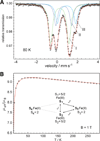N₂reduction and hydrogenation to ammonia by a molecular iron-potassium complex
- PMID: 22076372
- PMCID: PMC3218428
- DOI: 10.1126/science.1211906
N₂reduction and hydrogenation to ammonia by a molecular iron-potassium complex
Erratum in
- Science. 2014 Feb 21;343(6173):839
Abstract
The most common catalyst in the Haber-Bosch process for the hydrogenation of dinitrogen (N(2)) to ammonia (NH(3)) is an iron surface promoted with potassium cations (K(+)), but soluble iron complexes have neither reduced the N-N bond of N(2) to nitride (N(3-)) nor produced large amounts of NH(3) from N(2). We report a molecular iron complex that reacts with N(2) and a potassium reductant to give a complex with two nitrides, which are bound to iron and potassium cations. The product has a Fe(3)N(2) core, implying that three iron atoms cooperate to break the N-N triple bond through a six-electron reduction. The nitride complex reacts with acid and with H(2) to give substantial yields of N(2)-derived ammonia. These reactions, although not yet catalytic, give structural and spectroscopic insight into N(2) cleavage and N-H bond-forming reactions of iron.
Figures




Similar articles
-
Hydrogenation and cleavage of dinitrogen to ammonia with a zirconium complex.Nature. 2004 Feb 5;427(6974):527-30. doi: 10.1038/nature02274. Nature. 2004. PMID: 14765191
-
Accessibility and selective stabilization of the principal spin states of iron by pyridyl versus phenolic ketimines: modulation of the 6A1 ↔ 2T2 ground-state transformation of the [FeN4O2]+ chromophore.Inorg Chem. 2012 Aug 6;51(15):8241-53. doi: 10.1021/ic300732r. Epub 2012 Jul 18. Inorg Chem. 2012. PMID: 22808945
-
Dinitrogen cleavage and hydrogenation by a trinuclear titanium polyhydride complex.Science. 2013 Jun 28;340(6140):1549-52. doi: 10.1126/science.1238663. Science. 2013. PMID: 23812710
-
Dinitrogen binding and cleavage by multinuclear iron complexes.Acc Chem Res. 2015 Jul 21;48(7):2059-65. doi: 10.1021/acs.accounts.5b00213. Epub 2015 Jun 23. Acc Chem Res. 2015. PMID: 26099821 Free PMC article. Review.
-
Challenges in reduction of dinitrogen by proton and electron transfer.Chem Soc Rev. 2014 Aug 7;43(15):5183-91. doi: 10.1039/c4cs00085d. Chem Soc Rev. 2014. PMID: 24802308 Review.
Cited by
-
Experimentally quantifying small-molecule bond activation using valence-to-core X-ray emission spectroscopy.J Am Chem Soc. 2013 Aug 14;135(32):11803-8. doi: 10.1021/ja3116247. Epub 2013 Jul 30. J Am Chem Soc. 2013. PMID: 23862983 Free PMC article.
-
Nanostructured photoelectrochemical solar cell for nitrogen reduction using plasmon-enhanced black silicon.Nat Commun. 2016 Apr 20;7:11335. doi: 10.1038/ncomms11335. Nat Commun. 2016. PMID: 27093916 Free PMC article.
-
NH3 formation from N2 and H2 mediated by molecular tri-iron complexes.Nat Chem. 2020 Aug;12(8):740-746. doi: 10.1038/s41557-020-0483-7. Epub 2020 Jun 29. Nat Chem. 2020. PMID: 32601410
-
Synthesis, spectroscopy, and hydrogen/deuterium exchange in high-spin iron(II) hydride complexes.Inorg Chem. 2014 Mar 3;53(5):2370-80. doi: 10.1021/ic4013137. Epub 2014 Feb 20. Inorg Chem. 2014. PMID: 24555749 Free PMC article.
-
Effects of N2 Binding Mode on Iron-Based Functionalization of Dinitrogen to Form an Iron(III) Hydrazido Complex.J Am Chem Soc. 2018 Jul 11;140(27):8586-8598. doi: 10.1021/jacs.8b04828. Epub 2018 Jun 29. J Am Chem Soc. 2018. PMID: 29957940 Free PMC article.
References
-
- Smil V. Sci. Am. 1997;277:76.
-
- Mittasch A. Geschichte der Ammoniaksynthese. Weinheim: Verlag Chemie; 1951.
-
- Schlögl R. Handbook of Heterogeneous Catalysis. 2nd Ed. vol. 5. Weinheim: Wiley-VCH; 2008. pp. 2501–2575.
-
- Hellman A, et al. J. Phys. Chem. B. 2006;110:17719. - PubMed
-
- Burgess BK, Lowe DJ. Chem. Rev. 1996;96:2983. - PubMed
Publication types
MeSH terms
Substances
Grants and funding
LinkOut - more resources
Full Text Sources
Other Literature Sources

